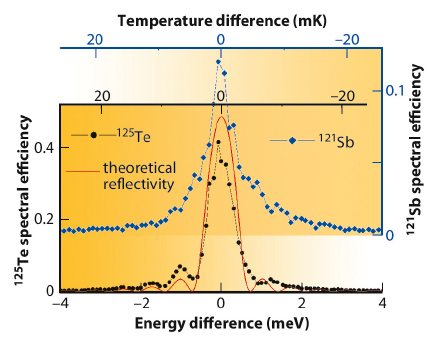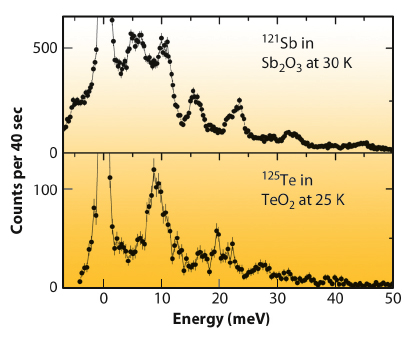- Home
- Users & Science
- Scientific Documentation
- ESRF Highlights
- ESRF Highlights 2011
- Dynamics and extreme conditions
- Sapphire monochromator for hard X-rays (> 30 keV) with sub-meV bandwidth
Sapphire monochromator for hard X-rays (> 30 keV) with sub-meV bandwidth
High efficiency nuclear inelastic scattering measurements above 30 keV with sub-meV resolution are now possible through the use of a sapphire backscattering monochromator in combination with improved upstream X-ray optics at the nuclear resonance beamline ID18. This development permits detailed lattice dynamics characterisation of novel functional materials based on elements such as tellurium and antimony.
Sub-meV monochromatisation of X-rays with high efficiency is a keystone for inelastic scattering techniques such as inelastic X-ray scattering or nuclear inelastic scattering. Typically, meV monochromatisation is achieved by single crystal diffraction in backscattering geometry or by using a multiple crystal arrangement. Silicon is the material of choice, as large ingots of extremely good quality are available. However, both approaches encounter difficulties above 30 keV if monochromatisation at a specific energy is required. Backscattering from a crystal with lower symmetry than silicon, i.e. with a large spectral density of back reflections, may overcome these difficulties [1]. Sapphire is the best crystal material for achieving efficient monochromatisation for any X-ray photon energy above 20 keV by proper choice of Bragg reflection and temperature variation of the lattice spacing [1]. The only limiting factor is the availability of high quality defect free sapphire crystals.
 |
|
Fig. 24: The instrumental functions of the sapphire backscattering monochromator as measured by nuclear forward scattering from 125Te (black points) and 121Sb (blue squares) via variation of the sapphire temperature. The theoretical reflectivity for the (9 1 10 68) reflection and crystal of 1 mm thickness is shown as red line. |
Here, an approach is presented which demonstrates that an almost ideal performance can be achieved even with imperfect sapphire crystals. At beamline ID18, the synchrotron radiation beam was focused to 0.2 x 0.2 mm2 at the crystal position and a sapphire with a thickness of 1-2 mm was utilised. The part of the crystal with the best quality was selected and used as a monochromator. A test of the monochromator was performed at 35.49 and 37.13 keV, the nuclear resonance energies of 125Te and 121Sb, respectively. The (9 1 10 68) and (8 16 24 40) reflections were chosen to match the resonance energies of 125Te and 121Sb at 220 and 237 K, respectively. The sapphire crystal was installed in a cryostat developed in-house [2]. The instrumental function was measured by recording the time integrated nuclear forward scattering, see Figure 24. An energy resolution of ~0.7 meV (FWHM) was obtained for both energies. This resolution is close to the theoretically expected one for the (9 1 10 68) reflection and 1 mm crystal thickness. The good quality is also confirmed by the visible Pendellösung fringes due to the interference between the radiation reflected from the front and the back crystal surface.
With a 100 mA electron current a flux of 108 photons/sec was obtained with this monochromator. Thus, time efficient measurements of nuclear inelastic scattering can be carried out for compounds containing Te and Sb. This is demonstrated in Figure 25, where measured spectra of TeO2 and Sb2O3 with natural abundance of 125Te and 121Sb are shown. The data give direct access to the Sb and Te partial density of phonon states as well as dynamical and thermodynamical properties, e.g. Lamb-Mössbauer factor, mean sound velocity, Debye temperature.
 |
|
Fig. 25: Nuclear inelastic scattering spectra of Sb2O3 and TeO2 with natural abundance of 121Sb and 125Te. The total measurement time was ~2 hours for each spectrum. |
This new monochromator development has opened the field of nuclear inelastic scattering for many functional materials bearing Te and Sb, such as phase-change materials [3], thermoelectric materials [4], photovoltaic semiconductors, and iron-chalcogenide superconductors.
Principal publication and authors
I. Sergueev (a), H.-C. Wille (b), R.P. Hermann (c,d), D. Bessas (c,d), Y.V. Shvyd’ko (e), M. Zajcac (a,f) and R. Rüffer (a), J. Synchrotron Rad. 18, 802–810 (2011).
(a) ESRF
(b) DESY, Hamburg (Germany)
(c ) Jülich Center for Neutron Science JCNS and Peter Grünberg Institut PGI, JARA-FIT, Forschungszentrum Jülich GmbH, Jülich (Germany)
(d) Faculté des Sciences, Université de Liège (Belgium)
(e) APS, Argonne (USA)
(f) Faculty of Physics and Applied Computer Science, AGH University of Science and Technology, Kraków (Poland)
References
[1] For a review see Y. Shvyd’ko, X-Ray Optics. High-Energy-Resolution Applications, Springer Berlin, 98 (2004).
[2] P. van der Linden, H.-C. Wille and Y.V. Shvyd’ko, AIP Conf. Proc. 879, 915 (2007).
[3] T. Matsunaga et al., Adv. Funct. Mater. 21, 2232 (2011).
[4] A. Möchel et al., Phys. Rev. B 84, 064302 (2011).



